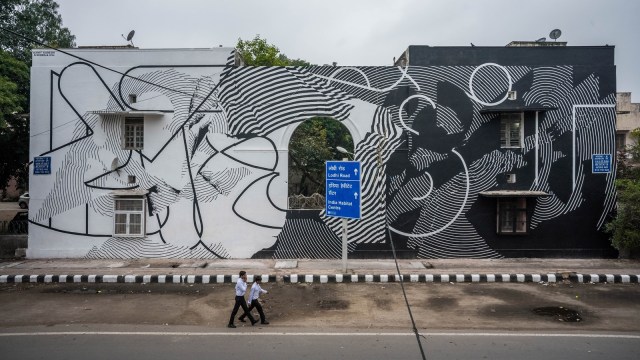From street to studio: Remembering artist Hanif Kureshi’s prolific work
Realising how patronage for the art form was dwindling, he began digitising typefaces and brought them under the banner of Handpainted Type
 Georgia Hill x Hanif Kureshi from 2019 Lodhi Art Festival (Credit: Gallery XXL)
Georgia Hill x Hanif Kureshi from 2019 Lodhi Art Festival (Credit: Gallery XXL)Artist Hanif Kureshi held a firm conviction that art possesses the power to connect with the masses and evoke a deeper emotional engagement. This belief not only inspired his interest in street art, but also informed his artistic expression.
From ‘We Love Dilli’ in Devanagari and the black-and-white ‘Yaha’ and ‘Must’ on building facades in Lodhi Colony to a mural on a municipal school that transforms the wall into an extension of the classroom, with motifs such as books, rulers and backpacks, several of his works still adorn the walls in the neighbourhoods of the Capital.
A year after he passed away last September, an exhibition at Delhi’s Gallery XXL has now brought together select works from his final five years.
“When he moved from Delhi to Goa in 2020, one of the first things he did was set up a studio to pursue his practice alongside the street art he continued to create,” recalls Arjun Bahl, co-founder of Gallery XXL and St+art India. Drawing similarities between both engagements, he adds, “He had a sharp, thoughtful mind and a clear understanding of both his own preferences and what people liked. His approach was to keep things simple and bold.”
Titled ‘Sabr, Ghar and Suroor’, the show that opened on October 12 to mark Kureshi’s 43rd birth anniversary includes, among others, the ‘Painter Kureshi’ series, rooted in hand-painted street typography, also recalling the times when as a young art graduate from MS University in Baroda, his interest in sign-board painting and hand-lettering prompted him to travel through the bylanes of India in search of street sign painters whom he began commissioning to paint alphabets in their unique styles and fonts.
Realising how patronage for the art form was dwindling, he began digitising typefaces and brought them under the banner of Handpainted Type. As a 16-year-old, he had also apprenticed with Saleem, a sign painter in Palitana (Gujarat), from whom he learned to work with radium stickers, fluorescent lights, CDs and steel plates to create licence plates.
While his explorations had given Kureshi a gateway into public art, in 2013-14 St+art India was founded to initiate art interventions in public spaces and take art to the streets where people lived. “Our aim is to make art more accessible. When you are working in an art gallery, your concerns are different, but this is art on the streets, for everyone,” stated Kureshi in an interview with The Indian Express in 2022.
While Delhi’s Lodhi Colony was one of the first neighborhoods transformed by St+art India into a public art district, with wall paintings in varied hues and themes, it was followed by similar initiatives in MS Maqta in Hyderabad, Dharavi in Mumbai and Panjim in Goa. “His work with sign painting also inspired him to take art to the streets… It was a very indigenous idea with humble beginnings, without much expectation… It remains a purist initiative at heart, where we are driven by the desire to contribute to our ever-growing, highly urbanised cities,” adds Bahl.
The exhibition also bridges Kureshi’s work on the streets to his studio. So in an untitled series, he plays with red and blue to investigate the materiality of metal and redefine linear perspective by distorting architectural angles. The acrylics Udaipur and Banaras are not mere landscapes but layered rectangular grids with a natural rhythm. Created months before he passed away, the Tetris series — named after ancient Greek city units — is painted in enamel on MS sheets, transforming letters into dynamic building blocks in motion, and inviting viewers to construct their own landscapes of colour and form.
The three works that form the title —’ Sabr, Ghar and Suroor’ — belong to the Urdu series. Giulia Ambrogi, chief curator and co-founder of Gallery XXL and St+art India Foundation, states, “Suroor, Ghar, and Sabr seem to slip away from the eye even as they enter it — rhythmic scripts oscillating between calligraphy and abstraction. Ghar (home), Suroor (joy), and Sabr (perseverance) embody Hanif’s approach to creation: rooted in joy, guided by belief, and sustained by perseverance. This is how he became a prolific creator across multiple fields — always remembering where he came from.” The exhibition is on till November 30.







